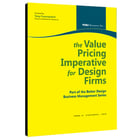To create value, a firm should throw out its “standard scope of work” and stop doing routine work for anyone and everyone. Focus. Specialize. Throw out the standard operating procedures (SOPs) for which you can charge only standard prices. Think beyond the traditional realm in providing services to clients.
There are five basic ways to value price:
1. Miniscope. Create value by assembling different service elements that normally would involve the firm in additional assembly effort and specialized decision skills/experience.
Example: A proposal for construction of a bridge could be bundled with a method of funding, future expansion options, a five-year maintenance program, a traffic management system, or some combination thereof. You may offer a comprehensive multidisciplinary service so that the client deals with one consultant—you.
2. Exploit competitive advantage. Determine which of your firm’s strengths and capabilities are most important to the client, and which would be difficult for another firm to duplicate.
Examples: One of your employees is the leading expert in a particular field; you have a full quality management program in place; your fee proposal enables the client to match their cash flow for your payments; your firm’s name on the project credits will be an advantage in obtaining approvals and in marketing the result; your staff members display an understanding of the client’s industry, thus saving “briefing time” and increasing trust level.
3. Facilitate lifecycle gains. Create future value for the client by providing for reduced operating costs resultant from your design. This is not the product lifecycle, but refers to the lifecycle costs of the building. For instance, different designs in commercial buildings may have higher initial costs but lower management costs over the life of the building.
Example: Each firm has firsthand knowledge of contractors, suppliers, and local conditions in the geographic area. The firm can offer post-completion services there conveniently and at low cost; it has special abilities based on operating knowledge of such processes, in controlling project costs and schedules beyond the construction phase.
4. Exploit Technological Advances. Use the most beneficial applications of the latest advances in technology that will benefit the client in a measurable way.
Examples: The development of green or sustainable buildings for energy conservation and user efficiency; or, understanding the client’s intended use of a project to incorporate design aspects that enable of the latest communication and information technology applications. Perhaps the firm has just developed a new computer program that has particular relevance to the client’s needs.
5. Facilitate repositioning to exclude external threats. All businesses are subject to external competitive threats. Collectively, the structure of these threats determine a company’s profitability. Therefore, a value pricing strategy may be used to minimize these threats and maximize profitability.
Example: In the aluminum industry, the major threat typically comes from the rivalry between firms already in the field. If you can reduce this threat by, say, reducing the processing time of your design, you have provided a premium that is of value to the client.
How do you value price and why?
Please let us know in the comment field below.
This is an excerpt from The Value Pricing Imperative for Design Firms. Purchase HERE to read more.



